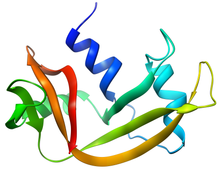Ribonuclease S
| Pancreatic ribonuclease | |||||||||
|---|---|---|---|---|---|---|---|---|---|

Structure of RNase A
|
|||||||||
| Identifiers | |||||||||
| EC number | 3.1.27.5 | ||||||||
| CAS number | 9001-99-4 | ||||||||
| Databases | |||||||||
| IntEnz | IntEnz view | ||||||||
| BRENDA | BRENDA entry | ||||||||
| ExPASy | NiceZyme view | ||||||||
| KEGG | KEGG entry | ||||||||
| MetaCyc | metabolic pathway | ||||||||
| PRIAM | profile | ||||||||
| PDB structures | RCSB PDB PDBe PDBsum | ||||||||
| Gene Ontology | AmiGO / QuickGO | ||||||||
|
|||||||||
| Search | |
|---|---|
| PMC | articles |
| PubMed | articles |
| NCBI | proteins |
Bovine pancreatic ribonuclease, also often referred to as bovine pancreatic ribonuclease A or simply RNase A, is a pancreatic ribonuclease enzyme that cleaves single-stranded RNA. Bovine pancreatic ribonuclease is one of the classic model systems of protein science. Two Nobel Prizes in Chemistry have been awarded in recognition of work on bovine pancreatic ribonuclease: in 1972, the Prize was awarded to Christian Anfinsen for his work on protein folding and to Stanford Moore and William Stein for their work on the relationship between the protein's structure and its chemical mechanism; in 1984, the Prize was awarded to Robert Bruce Merrifield for development of chemical synthesis of proteins.
Bovine pancreatic ribonuclease became a common model system in the study of proteins largely because it was extremely stable and could be purified in large quantities. In the 1940s Armour and Company purified a kilogram of protein - a very large quantity, particularly by the protein purification standards of the time - and offered samples at low cost to interested scientists. The ability to have a single lot of purified enzyme made it a predominant model system for protein studies. It remains commonly referred to as ribonuclease A or RNase A as the most prominent member of its protein family, known variously as pancreatic ribonuclease, ribonuclease A, or ribonuclease I.
...
Wikipedia
